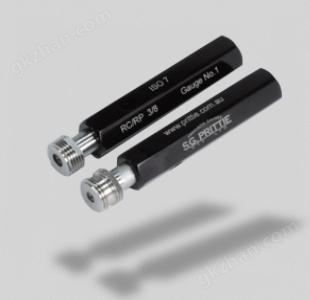万喜堂彩票 
万喜堂彩票 
| 暂无信息 |
万喜堂彩票注册开户 ISO 7-2 R锥度环规ISO 7-1锥度塞规ISO 7-2 Rp/Rc锥度塞规美国GSG螺纹量规



关注:惠氏锥管螺纹标准 E N 10226或者国际标准 ISO-7-2
ISO 7-2: Pipe Threads where Pressure-Tight Joints are made on the Threads; Part 2: Verification by means of Limit Gauges
ISO 7-2:2000 Foreword
This second Edition cancels and replaces the first edition (ISO 7-2:1982).
ISO 7-2:2000 Introduction
This revision of ISO 7-2 has been undertaken with the aim of providing a unified gauging system (1)(2) which could be adopted worldwide and thus eliminate the differing results (3) obtained with the use of gauges in accordance with ISO 7-2:1982 and existing national practices. This revision also includes details of plain ring gauges to provide additional means of checkingISO 7-1 external threads and a parallel modified thread form check ring gauge for checking taper full form treaded plug gauges.
ISO 7-2 Scope
This part of ISO 7 specifies a process using limit gauges, for the validation of taper internal and external threads and parallel internal threads on piping systems components and other products, the dimensions and tolerances of which are detailed inISO 7-1. The gauging system described may not be suitable, without special precaution, for gauging of threads on injections moulded plastic workpieces. This part of ISO 7 does not cover completely all the requirements necessary for full control of thread quality and dimensions. Additional control of tools and equipment and visual inspection during production are required to ensure complete compliance withISO 7-1, for example the length of useful thread on internally threaded workpieces should be checked by direct measurement. Annex A gives a summary of the gauges included in this part of ISO 7, together with details of the thread elements controlled by each gauge and gauge identification numbers. In the event of a dispute over compliance with the requirements ofISO 7-1, the gauges in this part of ISO 7 are to be considered as decisive for the thread elements which they control on the workpieces.
Notes:
1. Unified gauging system: The ISO 7-2:2000 gage design was protested by Japan; UK and USA representivies on the ISO committee; regardless; the standard was ratified.
2. Gage 3 has a single point contact on the taper thread which could rapidly wear and create erroneous readings.
3. Eliminate the differing results: A laudable goal, but with tapered pipe threads an impractical goal.
4. ISO 7-1 is technically equivalent toEN 10226-1 andEN 10226-2 combined.
5. ISO 7-2 is technically equivalent toEN 10226-3
E N 10226-3; Pipe Threads where Pressure Tight Joints are made on the Threads - Part 3: Verification by means of Limit Gauges
EN 10226-3 Foreword
ISO 10226-3 is based, with editorial modifications onISO 7-2“Pipe threads where pressure-tight joints are made on the threads- Part 2: Verification by means of Limit Gauges". Pipe thread gages defined by EN 10226-3 are dimensionally identical to and fully interchangeable with pipe threads toISO 7-2.
EN 10226 has been prepared in three parts.
Part 1 andPart 2 reflect the two thread joining systems in regular use in Europe and Worldwide.
Part 1 details taper external and parallel internal pipe threads.
Part 2 details taper external and taper internal pipe threads.
Part 3 details the requirements for the gauging of pipe threads conforming toPart 1 andPart 2.
EN 10226-2 Scope
EN 10226-3 specifies a process using limit gauges, for the validation of taper internal and external threads and parallel internal thread on piping system components and other products, the dimensions and tolerances of which are detailed inEN 10226-1,EN 10226-2andISO 7-1. In the event of a dispute over compliance with the requirements ofEN 10226-1,EN 10226-2 andISO 7-1, gages in EN 10226-3 andISO 7-2 are to be considered as decisive for the thread elements which they control on the work piece.
The EN 10226-3 gauging system described may not be suitable, without special precautions, for gauging of threads on injection molded plastic work pieces.
EN 10226-3 does not cover completely all requirements for full control of thread quality and dimensions. Additional control of tools and equipment and visual inspection during production are required to ensure complete compliance withEN 10226-1,EN 10226-2 andISO 7-1, for example the length of useful thread on internally threaded work pieces should be checked by direct measurement.
EN 10226-3 Annex A gives a summary of the gauges included in this document, together with details of the thread elements controlled by each gauge and gauge identification numbers.
EN 10226 Notes
Note 1: Threaded joints using taper external threads and parallel internal threads are detailed inEN 10226-1.
Note 2: The requirements for taper external threads are identical inEN 10226-1 andEN 10226-2. The common requirements for the taper external pipe thread are inPart 1 and inPart 2; so as to present the complete thread joining system in each part.
Note 3: For pipe threads where pressure-tight joints are not made on the threads seeISO 228-1.
Note 4: EN 10226-3 gives details of recommended gauging systems for the verification of thread dimensions and thread form. The gauging system defined in EN 10226-3 is technically equivalent to the gauging system defined inISO 7-2.
关注惠氏直管螺纹标准BS 2779,或者国际标准 ISO 228
British Standard Pipe Parallel ISO-228
The official name of the parallel pipe screw thread standard ISO 228 is: Pipe Threads Where Pressure-Tight Joints Are Not Made On The Threads.
This parallel pipe screw thread standard ISO 228 comes in two parts:
ISO 228; 2000: Part 1 Dimensions, Tolerances and Designation
ISO 228; 1987: Part 2 Verification by Means of Limit Gauges
Older standards that define the same thread are:BS 2779;DIN 2999.
您感兴趣的产品 PRODUCTS YOU ARE INTERESTED IN
智能制造网 设计制作,未经允许翻录必究 .
请输入你感兴趣的产品
请简单描述您的需求
请选择省份
 请输入计算结果(填写阿拉伯数字),如:三加四=7
请输入计算结果(填写阿拉伯数字),如:三加四=7  =
= 